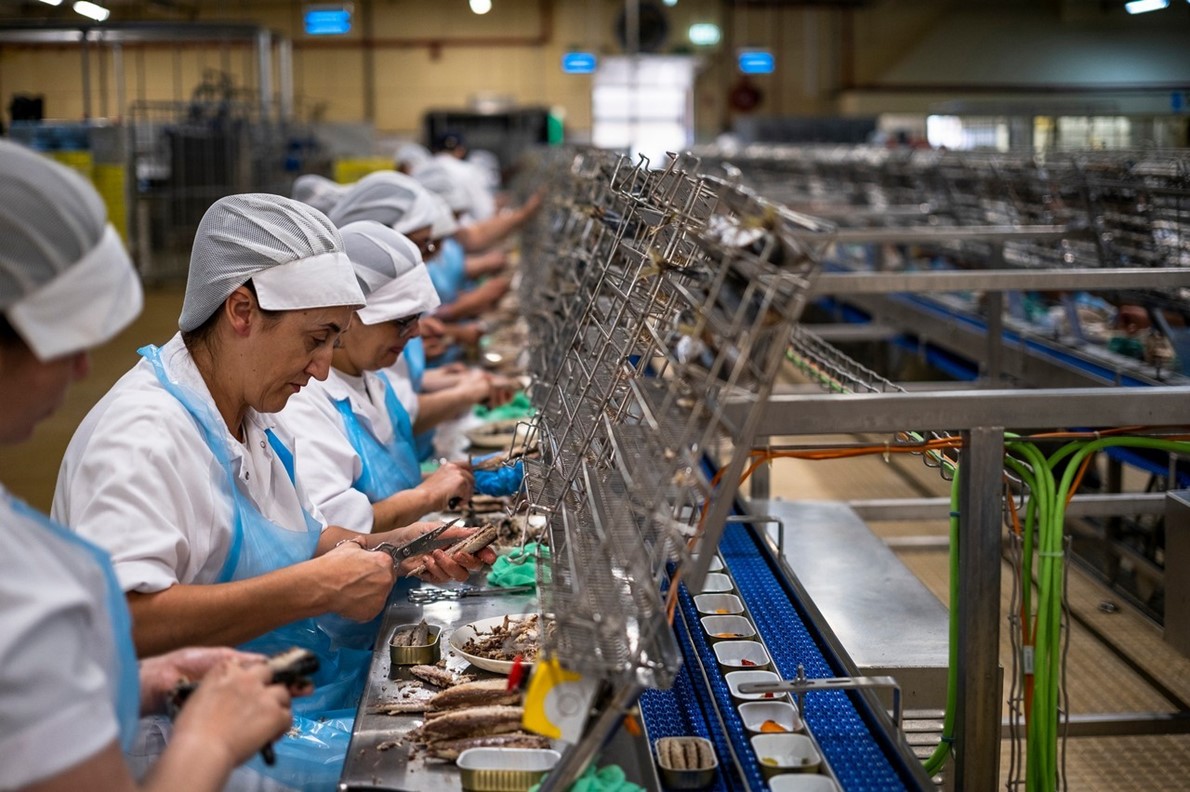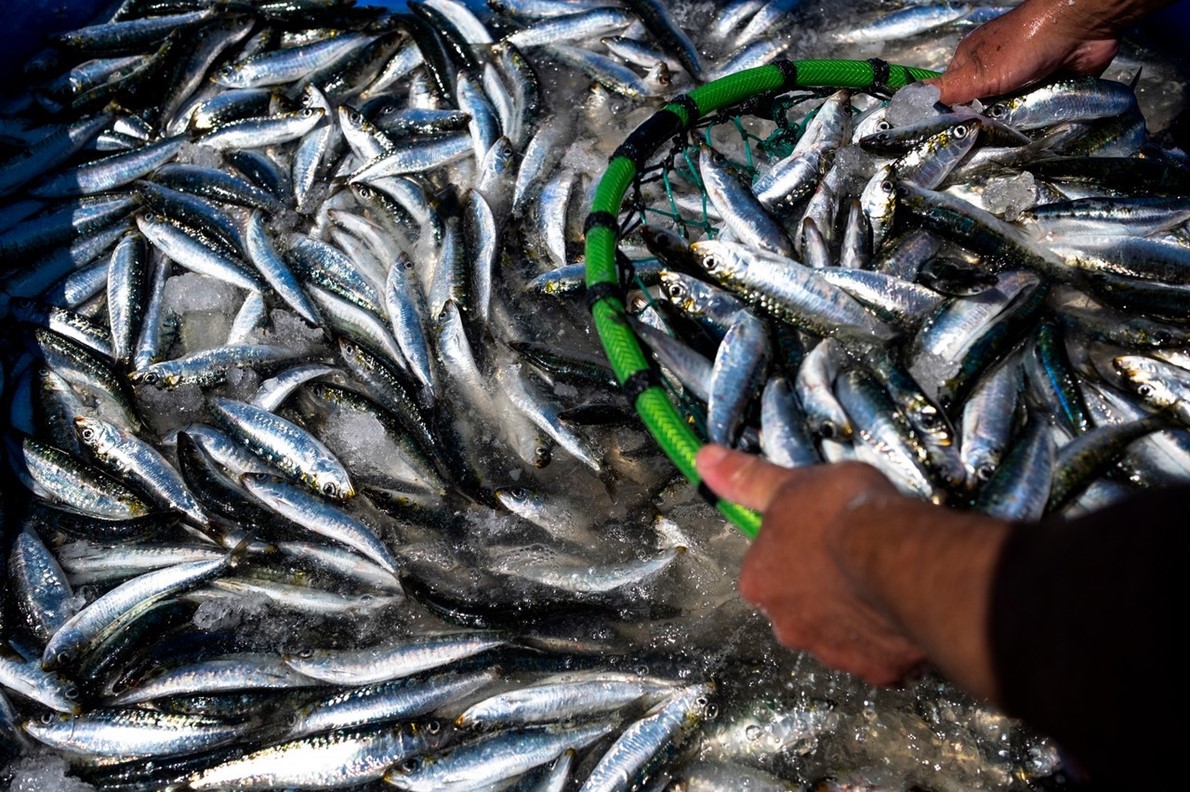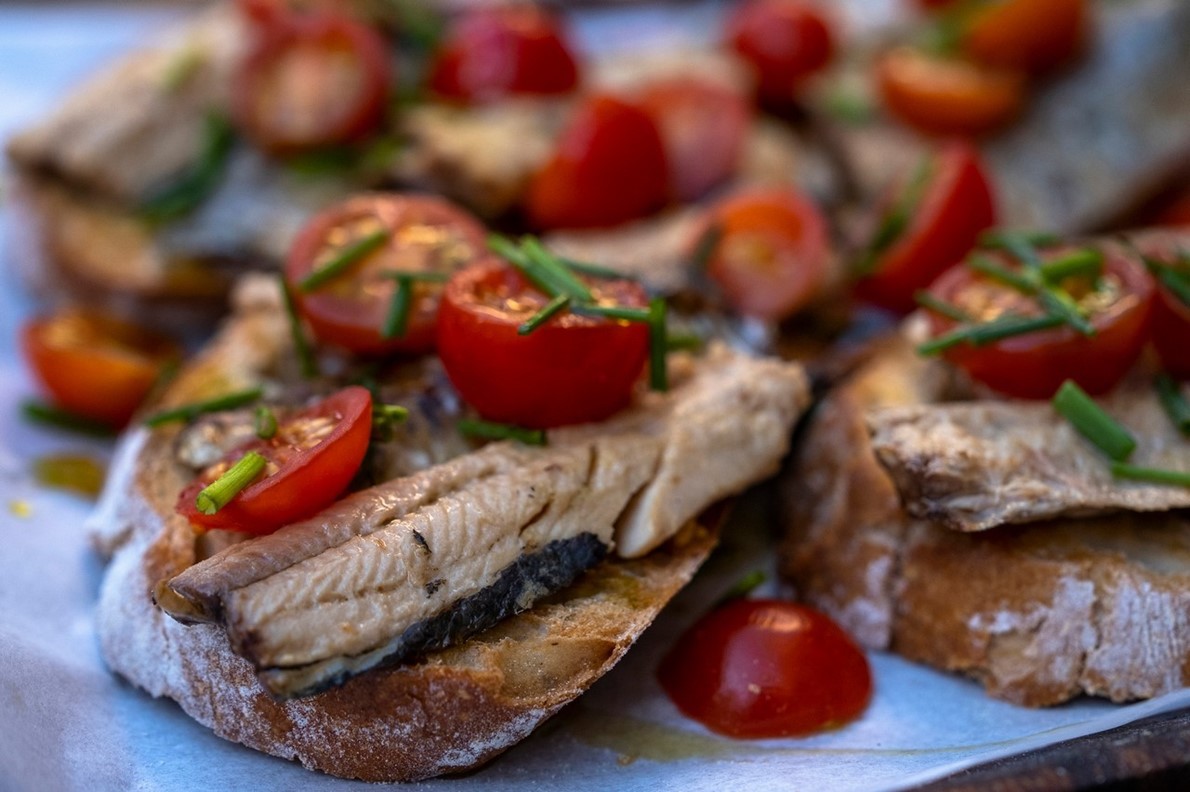In Portugal, taking a dive into sardines
New York Times
last updated: Jul 21,2022

All vacation is, in some way, an
observation of other people working while you do not. A stay at a hotel bears
witness to maids and hosts; dinner sees chefs, busboys, and waiters; an
excursion requires a tour guide, a driver, a boat mechanic if you are lucky.
But there’s a peculiarity in going to a working factory to stand on a raised
platform watching locals do hard, old-fashioned work, while you escape your own
job.اضافة اعلان
Porto, Portugal’s second-largest city, is the capital of one of the country’s major industries, fish canning. Canned sardines are having a moment in the food world. With exquisitely decorated tins, perceived if questionable sustainability, and the decadence of being drenched in oil, they have earned a devoted following among youngish people who love them with their whole hearts. At Conservas Pinhais e Cia in Matosinhos, a fish-canning factory just a few kilometers from the center of Porto, visitors are invited to see that their new favorite treat is, in fact, a very old operation.

Workers at the Conservas Pinhais e Cia factory prepare sardines to be steamed, in Matosinhos, Portugal, on July 4, 2022.
Founded in 1920 by two brothers and two outside partners, Pinhais is considered one of the best tinned-fish purveyors in the saturated Portuguese market. The company’s factory is one of the few that survived a great shift in sardine production to West Africa, where over half of all sardines are now canned. The sardines are favored among diners in the fish-centric city, and are a favorite across Europe, though US customers might be more familiar with the company’s international label, Nuri, which is bright yellow and available at specialty stores and fine groceries. The fish are known for their high quality and perfect seasoning — and now, on a tour of the working factory, sardine fans can see exactly how it’s done.
The workforce is almost all female, a tradition set by the fact that, historically, men went to sea while women stayed behind and dealt with the catch. It is not uncommon for generations of women to work in the factory, with mothers, daughters, and aunts finding steady jobs canning. Indeed, the tour of the sardine factory begins with a video of a Portuguese daughter, waiting for her father to make it through a storm. (He does.)

Fishermen sort out the day’s catch of sardines bound for the Conservas Pinhais e Cia factory in Matosinhos, Portugal, on July 4, 2022.
“That film is dedicated to all the families of our fishermen, for the stress they endure,” said the guide Olga Santos, at the start of a recent tour. Thus begins the entry to the wonderful, reverent world of canned sardines.
The 90-minute tour, which Pinhais introduced in November 2021, starts in an office originally built in 1926 and complete with rotary phones and a pulley system, on which orders would be attached to a rope and sent down to the factory floor, separating the office from the fish canning itself.
After the video of the fishermen’s families and one about how the fish’s seasonings are sourced, the screen rises to reveal a window on the working factory. You leave the impeccably decorated display area — the original founders shaped the stairwell so that when you look up in the factory foyer you see the outline of a sardine — for the nitty-gritty work area.

A worker prepares the daily catch of sardines for delivery to the Conservas Pinhais e Cia factory in Matosinhos, Portugal, on July 4, 2022.
After donning protective coverings, you enter along a walkway that runs around the edge of a mostly open floor, divided only by arched windows, save for a few offices where workers are typing on laptops. The first thing you see is a table of women cutting chili peppers, bay leaves, and pickles to fill the spicy versions of the company’s four varieties of sardines, which are offered either in tomato sauce or olive oil.
In the next area, the fish are bathed in salt water before having their heads and tails cut off with fish knives, which leaves some of the workers’ aprons stained with blood and guts. All extra parts go to animal food manufacturers, Santos tells us.
After the whacking, the remaining bodies are placed in a vertical container in individual slots that makes it look as though dozens of headless sardines are attending a lecture in a small hall. The auditorium is sent through a shower before entering a large oven, where the fish are cooked for 15 minutes. Then comes the delicate packing of the fish into their tins, by hand, before the tins are filled with olive oil using machinery, introduced a few years ago. In a promotional book you can purchase in the gift store, a few factory workers lament the new oil machine, remembering fondly getting “really covered” with the olive oil, which comes from the nearby Douro Valley.

A sample tray of sardines for visitors to the Conservas Pinhais e Cia factory, in Matosinhos, Portugal, on July 4, 2022.
The tins are sealed by machine, which accounts for some of the loud noise on the floor. Also loud is the constant flow of water, which rings throughout the factory as the sardines are washed several times before they are cooked. Other noises are harder to track: the oil spray, the wheels of pulleys rolling the fish from station to station, and the steam ovens all seem to create enough clamor that guests are given headphones to hear the guide while on the floor.
Finally, everything is packaged with lightning speed in what amounts to wrapping paper. You are given a chance to try this yourself in a closed-off room after exiting the tour and unwrapping yourself from the PPE, but it’s impossible to match the dexterity of the wrappers on the factory floor who wield the yellow, green, and blue papers with astonishing ease.
Santos told us that “on a good day” the women canning often sing. And, as we entered the factory floor, the cannery really was in full chorus, though the words were impossible to make out over the sound, even if you did speak Portuguese. Whether the singing is truly spontaneous is hard to know, but the myth of the women singing comes up when talking to locals familiar with the factory. Regardless, it seems just as likely that singing is the best way to communicate over the loud hum of sardine canning, whether it’s a good day or not.

Sardines on toast with fresh tomatoes at Aduela, a bar in Porto, Portugal, on July 4, 2022.
The tour ends with a sampling of the sardines that you have just seen canned, paired with bread from a local bakery and optional wine. The sardines, it must be said, are delicious. (And the smell in the factory is of freshly caught sardines going in and out of salt water.)
“I love sardines,” Sandra van Diessen, 57, visiting from the Netherlands, told me enthusiastically after the tour, as we debated the merits of deboning our free samples. (You are not supposed to, Santos told us, but the three of us laughed that we all did anyway, out of habit more than necessity.) After opening last fall and, with about 70 tours offered a week, in English, Spanish, Portuguese, and French, the factory has so far hosted 2,821 sardine fans. (Tours are 14 euros a person for adults, with 3 euros extra for wine; 8 euros for children.)
The city of Porto seemed to take pride in its worldwide industry. Throughout the small city, everyone I spoke to about the Pinhais factory echoed the same sentiments: these are good jobs, these are cherished employees and that the factory exists at all is a credit to the region itself.
“They are precious to us,” said Marta Azevedo, the communications director at ANCIP, the largest canning union in Portugal about Pinhais. “It’s the best canned fish we have, it’s the best place to work.”
But what about payment? It’s “not very good,” she admitted, estimating that women make roughly 800 euros a month, or about $832.
“But in Portugal, salaries are very low,” she went on. “They are well-paid, for Portugal.”

Sea gulls with their just-caught sardines in the fishing port at Porto, Portugal, on July 4, 2022.
Canned sardines are a common dish served throughout Portugal, and specialty stores in the city, like the pristine Loja das Conservas on the sloping Rua de Mouzinho da Silveira, just a few blocks from the Douro River, are dedicated to celebrating Pinhais products, along with other local brands like Minerva. A partnership with ANCIP, Loja has yet to resume its tastings since the pandemic, but the nearby Mercearia das Flores, on the quieter Rua das Flores, offers full tastings. Both shops, like the factory, are run by women, and you can pair your sardines on toast with local wines and fine chocolates.
There is, possibly, a small feud between those who serve the sardines fresh and those who serve them canned, according to the owner of Loja das Conservas, who told me darkly that “no one knows” why the finer restaurants will not serve the town’s famous tinned offering. Visitors looking to try the fish fresh have plenty of options, including the excellent Meia-Nau, where they come grilled to perfection. The modern restaurant, located on the chic Travessa de Cedofeita, requires reservations for dinner, but lunch is more open to visitors without a plan. If you happen to ask about the fresh-versus-canned debate, be sure to mention Loja — Meia-Nau’s owner, it turns out, is the son of the shop’s founder. In Porto, after all, sardines are a family business.
Read more Travel
Jordan News
Porto, Portugal’s second-largest city, is the capital of one of the country’s major industries, fish canning. Canned sardines are having a moment in the food world. With exquisitely decorated tins, perceived if questionable sustainability, and the decadence of being drenched in oil, they have earned a devoted following among youngish people who love them with their whole hearts. At Conservas Pinhais e Cia in Matosinhos, a fish-canning factory just a few kilometers from the center of Porto, visitors are invited to see that their new favorite treat is, in fact, a very old operation.

Workers at the Conservas Pinhais e Cia factory prepare sardines to be steamed, in Matosinhos, Portugal, on July 4, 2022.
Founded in 1920 by two brothers and two outside partners, Pinhais is considered one of the best tinned-fish purveyors in the saturated Portuguese market. The company’s factory is one of the few that survived a great shift in sardine production to West Africa, where over half of all sardines are now canned. The sardines are favored among diners in the fish-centric city, and are a favorite across Europe, though US customers might be more familiar with the company’s international label, Nuri, which is bright yellow and available at specialty stores and fine groceries. The fish are known for their high quality and perfect seasoning — and now, on a tour of the working factory, sardine fans can see exactly how it’s done.
The workforce is almost all female, a tradition set by the fact that, historically, men went to sea while women stayed behind and dealt with the catch. It is not uncommon for generations of women to work in the factory, with mothers, daughters, and aunts finding steady jobs canning. Indeed, the tour of the sardine factory begins with a video of a Portuguese daughter, waiting for her father to make it through a storm. (He does.)

Fishermen sort out the day’s catch of sardines bound for the Conservas Pinhais e Cia factory in Matosinhos, Portugal, on July 4, 2022.
“That film is dedicated to all the families of our fishermen, for the stress they endure,” said the guide Olga Santos, at the start of a recent tour. Thus begins the entry to the wonderful, reverent world of canned sardines.
The 90-minute tour, which Pinhais introduced in November 2021, starts in an office originally built in 1926 and complete with rotary phones and a pulley system, on which orders would be attached to a rope and sent down to the factory floor, separating the office from the fish canning itself.
After the video of the fishermen’s families and one about how the fish’s seasonings are sourced, the screen rises to reveal a window on the working factory. You leave the impeccably decorated display area — the original founders shaped the stairwell so that when you look up in the factory foyer you see the outline of a sardine — for the nitty-gritty work area.

A worker prepares the daily catch of sardines for delivery to the Conservas Pinhais e Cia factory in Matosinhos, Portugal, on July 4, 2022.
After donning protective coverings, you enter along a walkway that runs around the edge of a mostly open floor, divided only by arched windows, save for a few offices where workers are typing on laptops. The first thing you see is a table of women cutting chili peppers, bay leaves, and pickles to fill the spicy versions of the company’s four varieties of sardines, which are offered either in tomato sauce or olive oil.
In the next area, the fish are bathed in salt water before having their heads and tails cut off with fish knives, which leaves some of the workers’ aprons stained with blood and guts. All extra parts go to animal food manufacturers, Santos tells us.
After the whacking, the remaining bodies are placed in a vertical container in individual slots that makes it look as though dozens of headless sardines are attending a lecture in a small hall. The auditorium is sent through a shower before entering a large oven, where the fish are cooked for 15 minutes. Then comes the delicate packing of the fish into their tins, by hand, before the tins are filled with olive oil using machinery, introduced a few years ago. In a promotional book you can purchase in the gift store, a few factory workers lament the new oil machine, remembering fondly getting “really covered” with the olive oil, which comes from the nearby Douro Valley.

A sample tray of sardines for visitors to the Conservas Pinhais e Cia factory, in Matosinhos, Portugal, on July 4, 2022.
The tins are sealed by machine, which accounts for some of the loud noise on the floor. Also loud is the constant flow of water, which rings throughout the factory as the sardines are washed several times before they are cooked. Other noises are harder to track: the oil spray, the wheels of pulleys rolling the fish from station to station, and the steam ovens all seem to create enough clamor that guests are given headphones to hear the guide while on the floor.
Finally, everything is packaged with lightning speed in what amounts to wrapping paper. You are given a chance to try this yourself in a closed-off room after exiting the tour and unwrapping yourself from the PPE, but it’s impossible to match the dexterity of the wrappers on the factory floor who wield the yellow, green, and blue papers with astonishing ease.
Santos told us that “on a good day” the women canning often sing. And, as we entered the factory floor, the cannery really was in full chorus, though the words were impossible to make out over the sound, even if you did speak Portuguese. Whether the singing is truly spontaneous is hard to know, but the myth of the women singing comes up when talking to locals familiar with the factory. Regardless, it seems just as likely that singing is the best way to communicate over the loud hum of sardine canning, whether it’s a good day or not.

Sardines on toast with fresh tomatoes at Aduela, a bar in Porto, Portugal, on July 4, 2022.
The tour ends with a sampling of the sardines that you have just seen canned, paired with bread from a local bakery and optional wine. The sardines, it must be said, are delicious. (And the smell in the factory is of freshly caught sardines going in and out of salt water.)
“I love sardines,” Sandra van Diessen, 57, visiting from the Netherlands, told me enthusiastically after the tour, as we debated the merits of deboning our free samples. (You are not supposed to, Santos told us, but the three of us laughed that we all did anyway, out of habit more than necessity.) After opening last fall and, with about 70 tours offered a week, in English, Spanish, Portuguese, and French, the factory has so far hosted 2,821 sardine fans. (Tours are 14 euros a person for adults, with 3 euros extra for wine; 8 euros for children.)
The city of Porto seemed to take pride in its worldwide industry. Throughout the small city, everyone I spoke to about the Pinhais factory echoed the same sentiments: these are good jobs, these are cherished employees and that the factory exists at all is a credit to the region itself.
“They are precious to us,” said Marta Azevedo, the communications director at ANCIP, the largest canning union in Portugal about Pinhais. “It’s the best canned fish we have, it’s the best place to work.”
But what about payment? It’s “not very good,” she admitted, estimating that women make roughly 800 euros a month, or about $832.
“But in Portugal, salaries are very low,” she went on. “They are well-paid, for Portugal.”

Sea gulls with their just-caught sardines in the fishing port at Porto, Portugal, on July 4, 2022.
Canned sardines are a common dish served throughout Portugal, and specialty stores in the city, like the pristine Loja das Conservas on the sloping Rua de Mouzinho da Silveira, just a few blocks from the Douro River, are dedicated to celebrating Pinhais products, along with other local brands like Minerva. A partnership with ANCIP, Loja has yet to resume its tastings since the pandemic, but the nearby Mercearia das Flores, on the quieter Rua das Flores, offers full tastings. Both shops, like the factory, are run by women, and you can pair your sardines on toast with local wines and fine chocolates.
There is, possibly, a small feud between those who serve the sardines fresh and those who serve them canned, according to the owner of Loja das Conservas, who told me darkly that “no one knows” why the finer restaurants will not serve the town’s famous tinned offering. Visitors looking to try the fish fresh have plenty of options, including the excellent Meia-Nau, where they come grilled to perfection. The modern restaurant, located on the chic Travessa de Cedofeita, requires reservations for dinner, but lunch is more open to visitors without a plan. If you happen to ask about the fresh-versus-canned debate, be sure to mention Loja — Meia-Nau’s owner, it turns out, is the son of the shop’s founder. In Porto, after all, sardines are a family business.
Read more Travel
Jordan News


